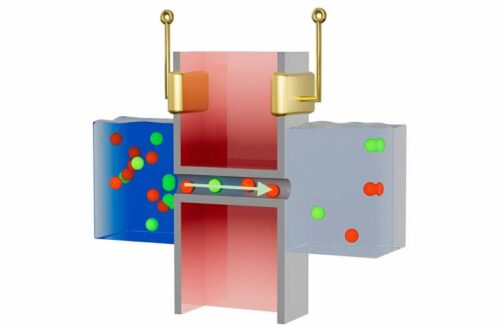A nanodevice unlocks the vast energy potential hidden in the world’s coastlines, tapping into the salinity contrast between seawater and freshwater discovering the exciting future possibilities and applications that could reshape how we view energy and its role in diverse fields.

There is a largely untapped energy source along the world’s coastlines: the difference in salinity between seawater and freshwater. A new nanodevice can harness this difference to generate power. When freshwater, like from a river, merges with saltier water, such as in an ocean, there’s a natural movement of salt molecules from areas of higher to lower concentrations. This movement carries energy involving ions – electrically charged particles originating from the dissolved salts.
University of Illinois Urbana-Champaign researchers have unveiled a nanofluidic device design in the Nano Energy journal that can transform ionic currents into electrical energy. The group envisions this device being instrumental in harnessing energy from the natural ionic movements found where seawater meets freshwater. Jean-Pierre Leburton, professor of electrical & computer engineering and the lead on the project, commented, “Although our design remains in its conceptual phase, its adaptability is impressive, and it demonstrates great promise for energy-related uses.”
They initiated a scholarly inquiry: Is a nanoscale solid-state apparatus feasible to harness energy from ionic movement? Yet, the results from their design went beyond their predictions and brought several surprises. The team led by Leburton crafted a minuscule semiconductor tool that leverages a process known as “Coulomb drag.” This process is the interaction between the moving ions and the device’s electrical charges. As ions traverse the device’s slender passage, electrical forces prompt the charges within the device to shift, thereby generating both voltage and electrical flow.
Coulomb Drag, Amplification, and the Future Scope
Upon simulating their device, the researchers encountered two unexpected outcomes. Initially, they had anticipated that the attraction between opposing electrical charges would largely drive the Coulomb drag. However, the simulations revealed that the device functioned as efficiently when the electrical forces were repelling. This means both positive and negative ions played a role in creating the drag. The team mentions that our discovery of an ‘amplification effect’ is equally significant. Given the substantial size of the moving ions relative to the device’s charges, these ions transfer a hefty momentum, bolstering the inherent electric current.” The team observed that these phenomena aren’t influenced by the particular design of the channel or the materials used. The only requirement is that the channel’s width remains sufficiently tight to maintain a close interaction between the ions and the electrical charges.
Currently, the team is seeking patents for their innovations and exploring how clusters of these mechanisms might be optimised for tangible energy production. Their projections suggest that the energy output from a collective array of these devices could rival, if not surpass, that of solar panels. The potential applications span other domains, including biomedical detection and advanced fluid dynamics at the nanoscale.







